SAFE AND STRONG
Personal Safety Strategies for People with Developmental Disabilities
WHO ARE WE TRYING TO REACH?
⋅ Train the trainer: parents, criminal justice and law enforcement, social and human service agencies, schools. ⋅ All people with developmental disabilities, including three major target audiences: 1) Children 8 and above and young adults receiving support in special education classes; 2) Adults with developmental disabilities in community residential services, including group homes, independent living, supported living; and 3) People in developmental centers.HOW DOES IT WORK?
⋅ SAFE AND STRONG provides empowering, real life strategies for personal safety.
⋅ Our instructional training package features video and INTERACTIVE workshops.
⋅ INTERACTIVE watching, listening and participating in SAFE AND STRONG modules via role paly.
⋅ INTERACTIVE response to trigger questions from curriculum, role modeling, coaches and peer students.
⋅ INTERACTIVE creation by students of their own trigger questions and their own role play and scenarios. Let’s meet our students where they are.
⋅ INTERACTIVE rehearsal, role play and modeling the SAFE AND STRONG way.
⋅ Video, trigger point discussion and role play provide a strong learning foundation for life saving personal safety skills. Small changes result in huge differences and positive outcomes.
⋅ Proven results and outcomes: lives have been changed. Enthusiastic endorsements from students, trainees, law enforcement, criminal justice and social service professionals, and teachers.
WHY KNOWLEDGE AND TRAINING ARE POWER!
Education and training are the keys to reducing crime and victimization against people with developmental disabilities.
⋅ Absence of safety training cultivates our people with DD to the ideal targets for predators – as predators are well aware.
⋅ SAFE AND STRONG provides empowering practical real life interactive a proactive step by step strategies for personal safety and risk reduction.
CHOOSE: NO NEUTRAL GROUND HERE
We can:
⋅ Give predators the power by avoiding and neglecting safety training with in our DD community;
OR
⋅ Provide our people with developmental disabilities the tools and power to reduce their risk and maintain safe behaviors.
WHAT WE KNOW:
People with developmental disabilities face disproportionate levels of crime:
⋅ People with DD face being victims of crime four to ten times higher thana the non-disabled population.
⋅ 90% of people with DD will experience physical or sexual abuse in their lifetime.
OUR GOAL:
REPLACE VULNERABILITY WITH POWER AND KNOWLEDGE VIA INTERACTIVE SAFETY TRAINING.
Let’s employ INTERACTIVE safety training to empower and strengthen our own population of people with DD instead of empowering predators.
Safe and Strong students, via INTERACTIVE training, modeling and rehearsal, are armed and instilled with automatic responses to recognize, avert and respond to dangerous situations.
WHY WE KNOW THIS WORKS
Proven results and outcomes: lives have been changed. SAFE AND STRONG trainings have received enthusiastic endorsements from students, trainees, law enforcement, criminal justice and social service professionals, and teachers and has been adapted in to school curricula.
WHO WE ARE AND WHY WE THINK WE CAN DO THIS
Authentic experts with real life step by step information and training have devoted their passion and careers to their individual areas of knowledge, and formed a spectacular collaborative project, including: California Department of Developmental Services, Tri-Counties Regional Center, Santa Barbara, Tri-Counties Justice and Disabilities Task Force, Lucaswrites Educational Media, Inc., with consultation and media services provided by Sheriff’s Department, Santa Barbara County; consultation with District Attorney and Victim/Witness Advocate Offices of Santa Barbara County. Funded by the California Department of Developmental Services Wellness Initiative Project and Tri-Counties Regional Center, Santa Barbara.
Curriculum based upon Portland Police Bureau SAFETY ZONE: COPS TALK: A Personal Safety Awareness Curriculum for People with Developmental Disabilities, a demonstration project funded by the U.S. Department of Justice, Office of Justice Programs and Bureau of Justice Assistance.
ABOUT SAFE AND STRONG AND HOW WE ORGAINZED THE DVD’s.
Safe and Strong includes four different DVD’s in one package.
⋅ Each DVD is in English with Spanish voice over.
⋅ Each DVD is divided into several modules.
⋅ Each module has a digital curriculum (which can be printed) which includes trigger questions, scenarios and related lessons.
⋅ Each DVD has both English and Spanish versions of the curriculm.
⋅ Use your computer to download the curriculum which accompanies each DVD.
⋅ Each DVD can be played on your computer and DVD player.
⋅ Each DVD has Spanish language voice over and Spanish translation of each accompanying curriculum.
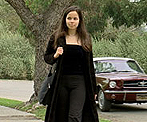
Achieving Confident Bearing:
How to achieve and demonstrate confident personal bearing and awareness of surroundings.
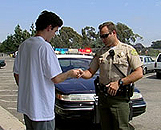
Interacting with Law Enforcement:
Appropriate interaction with Law Enforcement Officers. What to Say and Do.
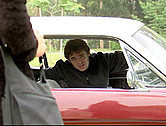
Recognizing Dangerous Situations:
The Safe Zone vs. The Unsafe Zone, plus 'Stranger Danger'. Includes avoiding White Collar Crime.
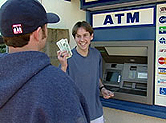
Awareness of Surroundings:
Strategies for behavior in Public Places, including ATMs, Shopping Centers and Restrooms.
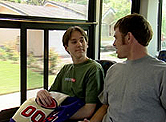
Public Transportation:
How to safely navigate with Public Transportation, including Bus and Taxi. Plus, more 'Stranger Danger'.
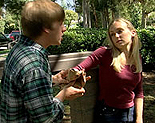
Preventing Sexual Assault:
Strategies to Stay Safe. How to respond to a known or Stranger Assailant. Plus, preventing Street Robbery.
Strategies for Personal Safety for Persons with Developmental Disabilities
A Four-Part Interactive Educational Video Series with Companion Printed Curriculum Multimedia Package
Part 1: Safety in the Community
Part 2: Sexual Assault, Victim/Witness
Part 3: Home Alone
Part 4: Appropriate Interactions with Law Enforcement
Providing empowering, real-life strategies for personal safety, Safe and Strong can help reduce crime and victimization against people with developmental disablities. Reflecting the actual
world we live in, Safe and Strong includes both non-disabled
and developmentally disabled participants.
When to Call 911:
How to Be Ready. What to Say, what to do with ID. Also, what to do if you are Lost.
Part 1: SAFETY IN THE COMMUNITY
1. Introduction
2. Confidence and Bearing
3. 911 Be Ready—what to say, what to do if you can not speak
4. Your ID/ Safe Person Card: Never Leave Home Without It
5. Your ID is for You, Your Money is for You
6. At The Bus Stop
7. On The Bus
8. ATM Awareness
9. Stranger Danger
10. If You Are Confronted
PART 2: SEXUAL ASSAULT/VICTIM/WITNESS
1. Review/Introduction
2. A Friendship Blossoms
3. Sexual Assault: Dorien’s Apartment
4. After the Assault: What to Expect:
⋅ Call 911
⋅ First Responder: Interviews with Law Enforcement
⋅ SART: Sexual Assault Response Team
⋅ Forensic Interview with Medical Nurse
⋅ Interview with Detective
⋅ Forensic Medical Exam
5. Victim/Witness Advocate:
⋅ There is Help for You
⋅ I Believe in You
6. Courtroom Orientation: What to Expect:
⋅ Prosecutor
⋅ Other People in the Courtroom (including the offender)
⋅ Hard Questions in the Witness Box
7. Sexual Molestation—Make it Stop!
⋅ Recognizing
⋅ Reporting
⋅ What to Expect
PART 3: HOME ALONE: SAFE AND STRONG
1. Introduction And Review
2. Home Security
3. Telephone Safety
4. Telemarketing: No Thank You, and Hang Up The Phone
5. Strangers At Your Door: Never Open The Door
6. If You Believe You Are In Danger: Call 911
7. Home Invasions: Get Out, Get Away, Get Help. Call 911
PART 4 ENCOUNTERS WITH LAW ENFORCEMENT
1. What To Do
2. Safe Card and ID
3. Who to call
3. What to Say
4. What Not to Say
CAUTIONS AND SENSITIVITIES
NEVER CRITICIZE. NEVER!
THE STAKES ARE VERY HIGH, AND YOU CANNOT UNRING THE BELL!!
BE POSITIVE! AND WE MEAN POSITIVE!
⋅ One criticism can paralyze a student with special needs and prevent learning by supporting a belief in shame and inadequacy. We all have a
lot to overcome—so let’s make sure we create an energy which makes our students bigger, not smaller.
⋅ Each of your students has heard it all before.
⋅ On the playground, bus, in the bathroom, whispered in the classroom, on the street.
⋅ Instead, ask students, John’s way is interesting—is there another way—can you show us?
BE SENSITIVE TO BODY LANGUAGE AND OTHER WAYS YOUR STUDENTS ARE COMMUNICATING
⋅ There is a possibility your student may have flashbacks--reignited traumas.
⋅ A flashback is not a memory recalled. A flashback is a reliving of the event, replete with all the horrors experienced, as if they were being re- experienced anew in the present moment.
⋅ If the trauma memory is reignited, students feel as though they are again in the middle of the traumatic experience, and have no control over their situation or reactions.
⋅ Students may have intensely vivid flashbacks, re-experiencing sights, sounds and sensations of the trauma as if it were happening all over again.
⋅ It is your responsibility to provide crisis intervention and counseling for the student.
⋅ Research! Be aware of counseling services available to your students.
⋅ Non-verbal students and students without readily accessible expressive language must be made aware that they are equally valuable people.
⋅ Students with crutches, canes, wheelchairs—all need to be accommodated in terms of confident presentation and safety skills, and of course need to be made aware that they are equally valuable people. They have heard otherwise often enough.
TRAINING TIPS FOR SAFE AND STRONG COACHES
It’s all about authentically listening and paying attention to what your students are trying to tell you, with or without words.
CAUTION COACHES! SEEK AND LOCATE COMFORT LEVELS!
Please be sensitive and cautious to the comfort levels of each student (see CAUTIONS AND SENSITIVITIES). A few reminders:
⋅ Many of your students are likely to have already been victims of crime.
⋅ Your goal is to empower these and all students.
⋅ Research, people, research. What resources are available to your students in need? Help them receive the counseling which is required to recover and live with the consequences of abuse and trauma.
⋅ Remember, most students with special needs have been bullied and shamed—your goal is to empower, strengthen already present strengths to bridge to areas of need, alert your students to their own self-worth.
INTERACTIVE PARTICIPATION IS VITAL
⋅ Safety training really only works when students are vitally, interactively, energetically involved participants.
⋅ Our students must learn automatic safety responses as if their lives depended upon learned safety training skills—because, often enough, they do.
⋅ Do not inflict students with the illusion that they have learned safety skills simply by watching Safe and Strong videos.
⋅ Interactive modeling and participation are FUN, and we really can only learn automatic safety training skills while we are having fun.
SPECIAL OLYMPICS MODEL
⋅ Our audiences respond well to this coach and team model.
⋅ You (the trainer) are the Safe and Strong home coach.
⋅ Your students/clients are your Safe and Strong home team.
⋅ Everyone participates. Everyone learns. Everyone wins.
⋅ No one, and we mean no one, is left out.
HOW DO WE DEFINE INTERACTIVE?
⋅ DO! MODEL! REHEARSE!
⋅ Every student models and rehearses each and every role in Parts: 1) Safety in the Community; 3) Home Alone and 4) Encounters with Law Enforcement. Not in
Part 2) Sexual Assault: Victim/Witness. Again, NOT in Part 2.
OUR SAFE AND STRONG COACH, GARY FRUIN, WILL CUE YOU:
⋅ “Home coaches, let’s check in with our Safe and Strong home team.” This is your cue to stop the video, ask questions and ask each student to model.
⋅ Watch the module as many times as you need to allow the information to make sense each student. Adjust as needed!
⋅ Ask your students for questions or comments. Read their faces! Read their body language!
⋅ Each student needs to participate and model safe behavior until it becomes automatic. No one has time to pause, consider and evaluate during a personal attack.
⋅ Do not model unsafe behaviors. Only model safe behaviors. Because it is important, we show unsafe behaviors only briefly for contrast. We then model safe behaviors and safety skills.
PACE AND FOCUS – Let’s meet our students on the road, right where they are.
⋅ You can begin at the beginning, with Part 1, Safety in the Community,
and
⋅ Focus on the individual modules which best serve your students in the moment.
⋅ What are their most critical needs? People at their door? People wanting to borrow money from our students? At the bus stop or on the bus? What happens if you are lost?
⋅ Home alone? Locked in the house with a potential abuser? Living with an abuser?
⋅ What are your students most critical fears? RESPOND!
KINDER AND GENTLER PLEADING? OR SAFE AND STRONG OR LOUD AND PROUD?
⋅ Big issues and challenges require big gestures and loud voices.
⋅ No predator has ever been discouraged or deflected by a potential victim’s quiet voice or conformity to good manners.
⋅ We face a great challenge—all of our special needs students have been taught conformity.
⋅ ATTENTION! Use one of your best weapons against crime—ATTENTION!
⋅ Do use loud voices and huge gestures presented in Safe and Strong. If your throat doesn’t hurt when you are done training, you haven’t shouted loud enough.
For more information, please contact
info@lucaswrites.com
A collaborative project of:
California Department of Developmental Services
Tri-Counties Regional Center
Tri-Counties Justice and Disabilities Task Force
and
Lucaswrites Educational Multi-Media, Inc.
Copyright
© 1998-2021
Lucaswrites Educational Multi-Media, Inc.
Also included in Part 1
When to Call 911:
How to Be Ready. What to Say, what to do with ID. Also, what to do if you are Lost.
Part 1: SAFETY IN THE COMMUNITY
1. Introduction
2. Confidence and Bearing
3. 911 Be Ready—what to say, what to do if you can not speak
4. Your ID/ Safe Person Card: Never Leave Home Without It
5. Your ID is for You, Your Money is for You
6. At The Bus Stop
7. On The Bus
8. ATM Awareness
9. Stranger Danger
10. If You Are Confronted
PART 2: SEXUAL ASSAULT/VICTIM/WITNESS
1. Review/Introduction
2. A Friendship Blossoms
3. Sexual Assault: Dorien’s Apartment
4. After the Assault: What to Expect:
⋅ Call 911
⋅ First Responder: Interviews with Law Enforcement
⋅ SART: Sexual Assault Response Team
⋅ Forensic Interview with Medical Nurse
⋅ Interview with Detective
⋅ Forensic Medical Exam
5. Victim/Witness Advocate:
⋅ There is Help for You
⋅ I Believe in You
6. Courtroom Orientation: What to Expect:
⋅ Prosecutor
⋅ Other People in the Courtroom (including the offender)
⋅ Hard Questions in the Witness Box
7. Sexual Molestation—Make it Stop!
⋅ Recognizing
⋅ Reporting
⋅ What to Expect
PART 3: HOME ALONE: SAFE AND STRONG
1. Introduction And Review
2. Home Security
3. Telephone Safety
4. Telemarketing: No Thank You, and Hang Up The Phone
5. Strangers At Your Door: Never Open The Door
6. If You Believe You Are In Danger: Call 911
7. Home Invasions: Get Out, Get Away, Get Help. Call 911
PART 4 ENCOUNTERS WITH LAW ENFORCEMENT
1. What To Do
2. Safe Card and ID
3. Who to call
3. What to Say
4. What Not to Say
CAUTIONS AND SENSITIVITIES
NEVER CRITICIZE. NEVER!
THE STAKES ARE VERY HIGH, AND YOU CANNOT UNRING THE BELL!!
BE POSITIVE! AND WE MEAN POSITIVE!
⋅ One criticism can paralyze a student with special needs and prevent learning by supporting a belief in shame and inadequacy. We all have a
lot to overcome—so let’s make sure we create an energy which makes our students bigger, not smaller.
⋅ Each of your students has heard it all before.
⋅ On the playground, bus, in the bathroom, whispered in the classroom, on the street.
⋅ Instead, ask students, John’s way is interesting—is there another way—can you show us?
BE SENSITIVE TO BODY LANGUAGE AND OTHER WAYS YOUR STUDENTS ARE COMMUNICATING
⋅ There is a possibility your student may have flashbacks--reignited traumas.
⋅ A flashback is not a memory recalled. A flashback is a reliving of the event, replete with all the horrors experienced, as if they were being re- experienced anew in the present moment.
⋅ If the trauma memory is reignited, students feel as though they are again in the middle of the traumatic experience, and have no control over their situation or reactions.
⋅ Students may have intensely vivid flashbacks, re-experiencing sights, sounds and sensations of the trauma as if it were happening all over again.
⋅ It is your responsibility to provide crisis intervention and counseling for the student.
⋅ Research! Be aware of counseling services available to your students.
⋅ Non-verbal students and students without readily accessible expressive language must be made aware that they are equally valuable people.
⋅ Students with crutches, canes, wheelchairs—all need to be accommodated in terms of confident presentation and safety skills, and of course need to be made aware that they are equally valuable people. They have heard otherwise often enough.
TRAINING TIPS FOR SAFE AND STRONG COACHES
It’s all about authentically listening and paying attention to what your students are trying to tell you, with or without words.
CAUTION COACHES! SEEK AND LOCATE COMFORT LEVELS!
Please be sensitive and cautious to the comfort levels of each student (see CAUTIONS AND SENSITIVITIES). A few reminders:
⋅ Many of your students are likely to have already been victims of crime.
⋅ Your goal is to empower these and all students.
⋅ Research, people, research. What resources are available to your students in need? Help them receive the counseling which is required to recover and live with the consequences of abuse and trauma.
⋅ Remember, most students with special needs have been bullied and shamed—your goal is to empower, strengthen already present strengths to bridge to areas of need, alert your students to their own self-worth.
INTERACTIVE PARTICIPATION IS VITAL
⋅ Safety training really only works when students are vitally, interactively, energetically involved participants.
⋅ Our students must learn automatic safety responses as if their lives depended upon learned safety training skills—because, often enough, they do.
⋅ Do not inflict students with the illusion that they have learned safety skills simply by watching Safe and Strong videos.
⋅ Interactive modeling and participation are FUN, and we really can only learn automatic safety training skills while we are having fun.
SPECIAL OLYMPICS MODEL
⋅ Our audiences respond well to this coach and team model.
⋅ You (the trainer) are the Safe and Strong home coach.
⋅ Your students/clients are your Safe and Strong home team.
⋅ Everyone participates. Everyone learns. Everyone wins.
⋅ No one, and we mean no one, is left out.
HOW DO WE DEFINE INTERACTIVE?
⋅ DO! MODEL! REHEARSE!
⋅ Every student models and rehearses each and every role in Parts: 1) Safety in the Community; 3) Home Alone and 4) Encounters with Law Enforcement. Not in
Part 2) Sexual Assault: Victim/Witness. Again, NOT in Part 2.
OUR SAFE AND STRONG COACH, GARY FRUIN, WILL CUE YOU:
⋅ “Home coaches, let’s check in with our Safe and Strong home team.” This is your cue to stop the video, ask questions and ask each student to model.
⋅ Watch the module as many times as you need to allow the information to make sense each student. Adjust as needed!
⋅ Ask your students for questions or comments. Read their faces! Read their body language!
⋅ Each student needs to participate and model safe behavior until it becomes automatic. No one has time to pause, consider and evaluate during a personal attack.
⋅ Do not model unsafe behaviors. Only model safe behaviors. Because it is important, we show unsafe behaviors only briefly for contrast. We then model safe behaviors and safety skills.
PACE AND FOCUS – Let’s meet our students on the road, right where they are.
⋅ You can begin at the beginning, with Part 1, Safety in the Community,
and
⋅ Focus on the individual modules which best serve your students in the moment.
⋅ What are their most critical needs? People at their door? People wanting to borrow money from our students? At the bus stop or on the bus? What happens if you are lost?
⋅ Home alone? Locked in the house with a potential abuser? Living with an abuser?
⋅ What are your students most critical fears? RESPOND!
KINDER AND GENTLER PLEADING? OR SAFE AND STRONG OR LOUD AND PROUD?
⋅ Big issues and challenges require big gestures and loud voices.
⋅ No predator has ever been discouraged or deflected by a potential victim’s quiet voice or conformity to good manners.
⋅ We face a great challenge—all of our special needs students have been taught conformity.
⋅ ATTENTION! Use one of your best weapons against crime—ATTENTION!
⋅ Do use loud voices and huge gestures presented in Safe and Strong. If your throat doesn’t hurt when you are done training, you haven’t shouted loud enough.
For more information, please contact
info@lucaswrites.com
A collaborative project of:
California Department of Developmental Services
Tri-Counties Regional Center
Tri-Counties Justice and Disabilities Task Force
and
Lucaswrites Educational Multi-Media, Inc.
Copyright
© 1998-2021
Lucaswrites Educational Multi-Media, Inc.